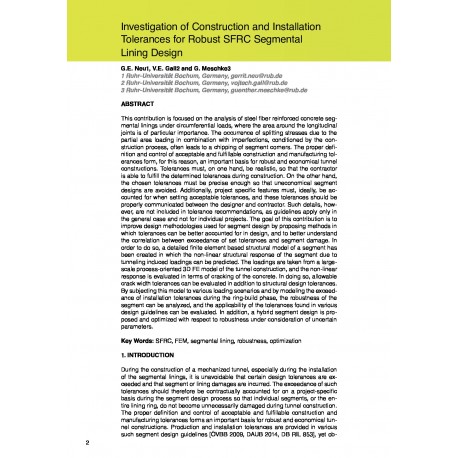Cart
0
0
No document
0,00 €
Total
Document successfully added to your shopping cart
Quantity
Total
There are 0 items in your cart.
There is 1 item in your cart.
Total documents
Total shipping
To be determined
Total
Search & filter
Search for a publication
Search & filter

Investigation of Construction and Installation Tolerances for Robust SFRC Segmental Lining Design
2769_investigation_of_constructi
G. Meschke / V. E. Gall / G. E. Neu
This contribution is focused on the analysis of steel fiber reinforced concrete segmental linings under circumferential loads, where the area around the longitudinal joints is of particular importance. The occurrence of splitting stresses due to the partial area loading in combination with imperfections, conditioned by the construction process, often leads to a chipping of segment corners. The proper definition and control of acceptable and fulfillable construction and manufacturing tolerances form, for this reason, an important basis for robust and economical tunnel constructions. Tolerances must, on one hand, be realistic, so that the contractor is able to fulfill the determined tolerances during construction. On the other hand, the chosen tolerances must be precise enough so that uneconomical segment designs are avoided. Additionally, project specific features must, ideally, be accounted for when setting acceptable tolerances, and these tolerances should be properly communicated between the designer and contractor. Such details, however, are not included in tolerance recommendations, as guidelines apply only in the general case and not for individual projects. The goal of this contribution is to improve design methodologies used for segment design by proposing methods in which tolerances can be better accounted for in design, and to better understand the correlation between exceedance of set tolerances and segment damage. In order to do so, a detailed finite element based structural model of a segment has been created in which the non-linear structural response of the segment due to tunneling induced loadings can be predicted. The loadings are taken from a largescale process-oriented 3D FE model of the tunnel construction, and the non-linear response is evaluated in terms of cracking of the concrete. In doing so, allowable crack width tolerances can be evaluated in addition to structural design tolerances. By subjecting this model to various loading scenarios and by modeling the exceedance of installation tolerances during the ring-build phase, the robustness of the segment can be analyzed, and the applicability of the tolerances found in various design guidelines can be evaluated. In addition, a hybrid segment design is proposed and optimized with respect to robustness under consideration of uncertain parameters.


